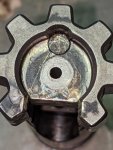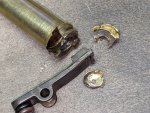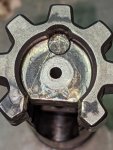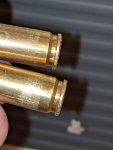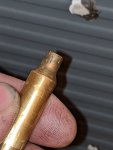can anyone please tell me what and how this happened. I took my AR-10 to the range yesterday . sighting in my scope @100 I brought some hand loads with me. ALL loaded to Manufacturer Specs. I had some Nosler, some Hornady, Sierra, and Berger bullets ,,, 10 of each. loaded with varying powder charges... All within specs. I loaded my 10 round mag ,, slapped it in , charged the rifle and Click ,,,, nothing .... ejected it ,,small mark on the primer but nothing to indicate it was struck hard. racked another one is and CLICK ,,,,,, again . At this point I dropped the mag , hand loaded one into the chamber and closed the bolt ,, pulled the trigger and BANG , she goes off. Ok from that point i would load the first one by hand ,, then slap the mag in and it seemed to run fine.
Now,,, this is what I do not understand. On the last shot . I did the sam thing , hand loaded the first round, sent the bolt home , slapped the mag in and fired the rifle. As SOON as it went off I KNEW something was wrong. No reciprocation, no ejection , just a bigger than normal bang and recoil . The bolt was LOCKED in the battery position ,,, That ended my day and when I got it home it took and hour of tapping, smacking , and working to get it opened. and when i did ,,, I found the case was damn near seized onto the bolt face and had to be pried off . I've been reloading now for well over 4 years and have loaded THOUSANDS of rounds , both pistol and rifle . But I've NEVER seen this happen . the case was a once fired 6.5 cm case ,, cleaned resized and reloaded to proper COL. 2.800 The case was blown apart at the base,... it even bent the extractor . ( see pics) ... the chamber was undamaged , as was the carrier but the bolt took some damage, I've re ordered another bolt. So ,,, with all that being said ,, does anyone know WTF happened? you can even see where the pressure was so high it flowed the brass back into the hole where the ejector is, and pushed the ejector flush with the bolt face. Th FUK just happened?
Now,,, this is what I do not understand. On the last shot . I did the sam thing , hand loaded the first round, sent the bolt home , slapped the mag in and fired the rifle. As SOON as it went off I KNEW something was wrong. No reciprocation, no ejection , just a bigger than normal bang and recoil . The bolt was LOCKED in the battery position ,,, That ended my day and when I got it home it took and hour of tapping, smacking , and working to get it opened. and when i did ,,, I found the case was damn near seized onto the bolt face and had to be pried off . I've been reloading now for well over 4 years and have loaded THOUSANDS of rounds , both pistol and rifle . But I've NEVER seen this happen . the case was a once fired 6.5 cm case ,, cleaned resized and reloaded to proper COL. 2.800 The case was blown apart at the base,... it even bent the extractor . ( see pics) ... the chamber was undamaged , as was the carrier but the bolt took some damage, I've re ordered another bolt. So ,,, with all that being said ,, does anyone know WTF happened? you can even see where the pressure was so high it flowed the brass back into the hole where the ejector is, and pushed the ejector flush with the bolt face. Th FUK just happened?

